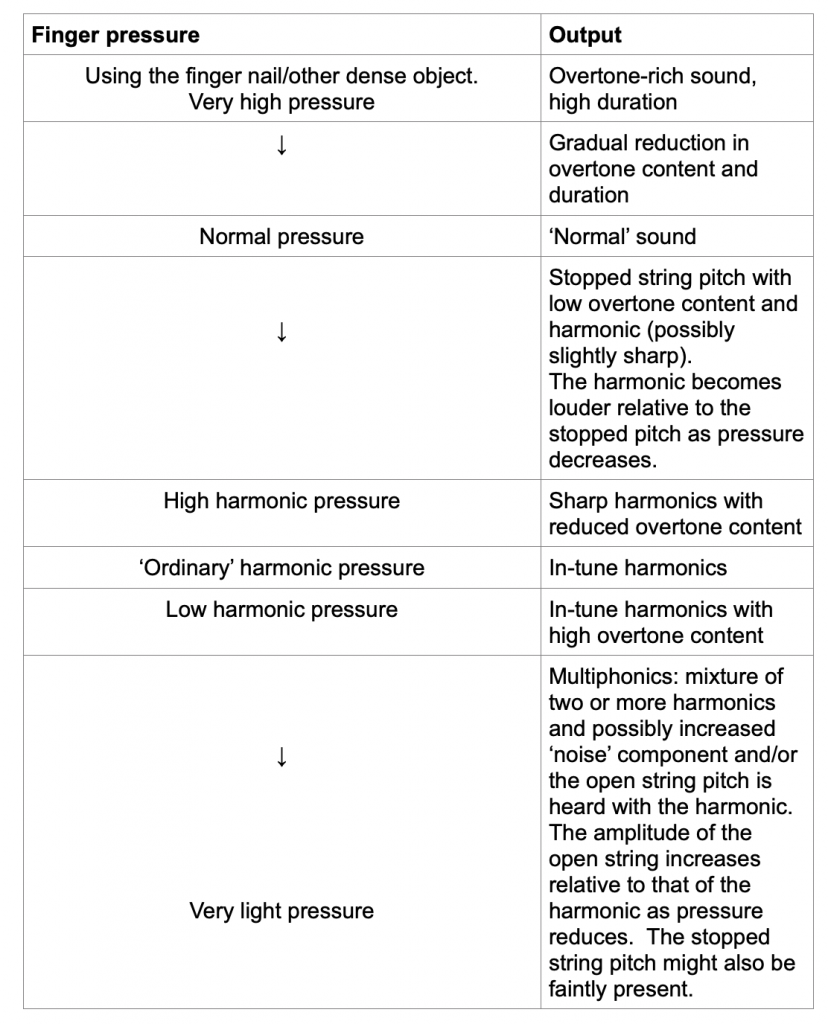There is a scale of finger pressure. From high to low pressure: tones are overtone-rich with a long decay, harmonics and stopped string sound are combined, harmonics, harmonics combined with the open string, multiphonics and a noise component are heard.
▶︎HIGH PRESSURE
High pressure at the stopping finger allows an overtone-rich sound with a long decay. Stopping the string with the fingernail or another dense object is overtone-richer and has longer decay times.
▷IN CONTEXT
Too much pressure with the left hand is counter-productive; it can cause unwanted tension in the right hand that restricts loudness and overtone content.
▶︎SLIDE EFFECTS
If a dense object stops the string (a pen, a glass rod), even without pressing it to the fingerboard, long glissandi are possible, like the guitarists’ slide techniques. Cello map link
▶︎HARMONIC PRESSURE
For harmonics, the finger touches the string without pressing it to the fingerboard. Within the range of ‘harmonic finger pressure’ there is scope for some variation and many sounds are possible.
At high harmonic finger pressure the string is slightly depressed but not in contact with the fingerboard. This is often called a ‘half harmonic’. The pitch of the harmonic (probably slightly sharp) and the tone at the stopping point are both heard. The sound is overtone-weak.
▷TIP
At the harmonic node closest to the bridge, the harmonic pitch and the stopped pitch are always the same. Therefore, for a ‘half harmonic’, it is impossible to hear two combined pitches at this point. However, compared to a ‘normal harmonic’ overtone content is noticeably reduced by the damping caused by the extra surface area and string bending due to the touching finger conditions for harmonics.
At mid-high harmonic finger pressure, the harmonic sounds alone, usually slightly sharp with weak overtone content. As pressure decreases, the harmonic’s pitch falls to normal and overtone content becomes richer.
▶︎LOW PRESSURE
Under very low finger pressures, the pitch of the open string is introduced into the sound in addition to a harmonic. It is possible that two or more harmonics (including the open string) sound simultaneously. This is called a multiphonic.
▷A NOTE ON BOWING
Under low pressures, there might be a forced, ‘stuttering’ sound. This is particularly strong at low bow speeds.
▶︎▶︎NOTE
The flexibility and the outcome of varying finger pressure changes for different positions on the fingerboard.
Lower harmonics are more flexible: it is possible to change the sound and maintain the relatively constant presence of a harmonic.
Higher harmonics are more sensitive: a change in finger pressure sometimes causes the harmonic to ‘jump’ to a neighbouring harmonic.
▶︎MULTIPHONICS
For more detailed information about multiphonics, see Cello map link
In this context, I will define a multiphonic as the simultaneous sounding of two or more harmonics on a single string. This can include the open string (which is the first harmonic). Multiphonics are easier to produce in certain areas of the string; especially at points on the string where there is a cluster of harmonic nodes. Multiphonics also require some manipulation of the sound in the right hand.
▶︎SCALE OF FINGER PRESSURE
It is possible to summarise a scale of finger pressure:

A scale of finger pressure for the bowed string.
▶︎▶︎NOTE
In the first example in this video, the stopping finger is at the third harmonic on the D string, not very close to a cluster of harmonics. Therefore, the transition to the harmonic sound is relatively clean. In the second example, the finger is very close to both the sixth and seventh harmonics on the G string. The transition to harmonic sound is more complex, with some fluctuation between sixth and seventh harmonics and some multiphonic vibration.

